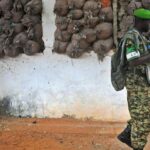
KYIV — One by one, the mourners gathered at the gilded St. Michael’s cathedral, flowers in one hand and crossing themselves with the other, to pay their respects to Vira Hyrych.
Hyrych, a journalist for the U.S.-funded Radio Free Europe/Radio Liberty’s Ukrainian service, was killed on April 28, when a Russian cruise missile crashed into her apartment in central Kyiv, shattering the lives of hundreds who resided in the 25-story building and reminding residents of this city that any semblance of normalcy that they may have felt since Vladimir Putin’s military retreated from the capital last month was just an illusion.
Hyrych’s body was recovered from the smoldering pile of rubble the next day. The attack occurred during the visit of U.N. Secretary-General António Guterres, who had been in Moscow the day before to meet face-to-face with Putin in the Kremlin.
Hyrych, the seventh journalist killed since Russia’s full-scale invasion of Ukraine began on Feb. 24, was laid to rest May 3, on World Press Freedom Day. Her last story was published posthumously: It was about an 87-year-old woman who survived the Holocaust, the Nazi siege of Leningrad, and now the Russian bombing of Mariupol, which she said was worse than anything she previously experienced.
Russian forces have pulled back from areas around Kyiv after a month-long occupation, but they left death and destruction on a horrendous scale. The bodies of 1,202 civilians have been found scattered and buried in mass graves around the region, Kyiv Regional Police Chief Andriy Nebytov reportedly said during a Ukrainian TV interview on May 2. He said the true death toll is likely much higher. The Prosecutor General’s Office has opened cases on 9,602 crimes of aggression and war crimes.
If some residents who fled in the early days of the invasion thought they could return to the safety of their homes to resume their lives, the attack on Kyiv that took Hyrych’s life was a stark reminder that even with Russian troops hundreds of miles to the east the threat of missiles remains.
Russia’s war is still palpable in Kyiv, even as Putin shifts the focus of his military operation to Ukraine’s eastern Donbas region. And there is a militaristic element to nearly every aspect of life now.
The scorched hulks of Russian tanks dot the E-40 highway heading to Kyiv, providing surreal selfie backdrops for returning residents. Many of the checkpoints that marked the city’s intersections have been dismantled, but the cement blocks and anti-tank metal “hedgehogs” still sit aside the road, ready to be moved back into place at a moment’s notice. Government offices, strategic buildings, and cultural landmarks are littered with barricades and mounds of sandbags.
Most lights go out after sundown, and there’s a heavy troop presence on the streets after curfew. On Tuesday evening, the air raid siren sounded across Kyiv’s city center, sending a shopkeeper on a smoke break and two friends into a nearby basement. There were no reports of missile strikes in the area; local authorities reported that air defense systems intercepted a missile aimed at Kyiv. Elsewhere, however, Russian missiles rained down, striking power substations in western Lviv and critical infrastructure across the country in what appeared to be one of the biggest missile bombardments in the past few weeks.
“They can come back at any moment,” Helena, a 34-year-old PR consultant told POLITICO as she sipped coffee on a park bench, referring to Russian soldiers who stormed into the area in February on tanks and dropped in by helicopters. “Putin wants to destroy us and he’s not finished.”
And yet, some shops and cafes have reopened. Central Khreshchatyk Street, Kyiv’s main artery, hums with traffic. And after several dry weeks, bars are now serving alcohol to war-weary customers. “We will drink to relax and we will to his death,” a wine shop employee serving a line of six people said about Putin, making a lewd gesture with her thumb and index finger.
Over the past week, 32 diplomatic missions have returned to work in the capital, according to the Ukrainian National Guard commander overseeing their protection. The U.S. Embassy is not yet one of them, but its charge d’affaires said Monday on her first visit to the country since the Russian invasion began that the mission could reopen by the end of May, if security conditions allow.
“We listen to the security professionals, and when they tell us we can go back we will go back,” Kristina Kvien told reporters in Lviv.
Despite the renewed activity in the city, the war is never far away. On central Independence Square on Tuesday afternoon, a crowd gathered to plead for international help to evacuate the hundreds of Ukrainian troops still holding onto the last bastion of Ukrainian-controlled territory in southeastern Mariupol, the Azovstal iron and steel factory.
There, Ukrainian troops from the 36th Separate Marine Brigade and the Azov Regiment, a unit of the country’s National Guard, have fought tooth and nail to keep Russian forces from taking the plant and killing the hundreds of civilians hunkered down inside its maze of tunnels and bunkers. The rest of Mariupol is in ruins.
After weeks of difficult negotiations, Russia finally agreed to release some of the trapped civilians. Their safe evacuation to the nearby city of Zaporizhzhia was confirmed by Ukrainian President Volodymyr Zelenskyy and Osnat Lubrani, the United Nations’ resident coordinator and humanitarian coordinator, who accompanied some of them to safety.
“I’m relieved to confirm that the safe passage operation from Mariupol has been successful,” she tweeted Tuesday. “The people I traveled with told me heartbreaking stories of the hell they went through. I’m thinking about the people who remain trapped. We will do all we can to assist them.”
Zelensksyy said in a late-night address that 156 people arrived in Zaporizhzhia. “Women and children. They have been in shelters for more than two months. Just imagine! For example, a child is six months old, two of which are underground, fleeing bombs and shelling,” he said. “Finally, these people are completely safe. They will get help.”
Meanwhile, Ukrainian fighters inside the plant reported a new wave of Russian bombs and said ground forces were attempting to storm them.
“Enemy naval artillery and barrel artillery worked all night on the territory of the Azovstal plant. Heavy aircraft bombs were dropped,” Sviatoslav Palamar, deputy commander of the Azov Regiment unit inside Azovstal said in a desperate video published on the group’s Telegram channel and circulated by Ukrainian media. Two civilian women were killed in the attack, he said.
At the Independence Square demonstration, Iryna Yehorchenko joined a group of family members and friends of the trapped Ukrainians in trying to rally support for an emergency evacuation. She told POLITICO that her 22-year-old son Artem is among the trapped Azov Regiment troops. The last time she heard from him was April 10. He wrote her over a messenger app to say that the group was running low on food and water and that medical supplies, including antibiotics needed to treat several seriously wounded people, were in limited supply.
“He told me they had now electricity sometimes and were living in the dark,” Yehorchenko said.
Oleg Yehorchenko, Artem’s uncle, told POLITICO he would like to see an evacuation like the one that Ukraine’s special forces pulled off in Afghanistan in September. Then, as the Taliban tightened its grip on Kabul and the U.S. and other countries scrambled to pull people out, the Ukrainians managed to airlift 96 Afghans to safety.
The only other option, the uncle said, was a daring humanitarian rescue orchestrated by a third country, possibly the U.S. But he wasn’t hopeful.
“They’re afraid to fly in there because it could start World War III,” he said. “But [the troops] are very close to dying and they will die soon if nobody helps them.”




